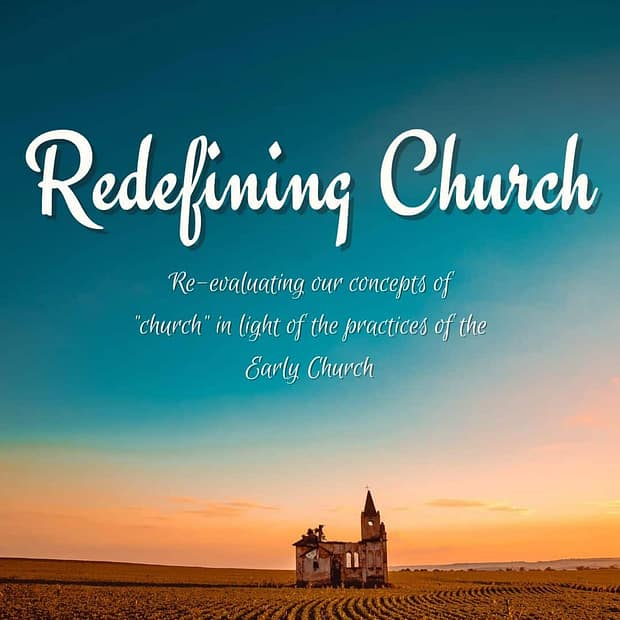In this series focusing on the model of church demonstrated by the earliest group of Christians, based on Acts 2:42-47, we come to the third of eight key concepts: the way in which the early church devoted themselves to the breaking of bread and to prayer. These were solid foundations upon which the faith of these new believers was built – and are foundations that should be (but not necessarily are) at the centre of the 21st Century church. Was the early church’s concept of the breaking of bread the same as our 21st Century interpretation, or are there lessons to be learned about the way we approach the “Lord’s Supper”? What does it really mean to be devoted to prayer, and what does that mean for how we view prayer?
Read: Acts 2:42-43:
They devoted themselves to the apostles’ teaching and to fellowship, to the breaking of bread and to prayer. Everyone was filled with awe at the many wonders and signs performed by the apostles.
As we’ve seen so far in this series, the way that we “do church” in the 21st Century doesn’t always match up with the model of the church that the first believers, following the Day of Pentecost, lived out. The modern-day church has, in many ways, lost some of the intensity and community that the early church thrived on. [ctt template=”8″ link=”UoDlr” via=”yes” ]Our version of church might be considered to be a watered-down version of the Acts 2 model, but it doesn’t have to stay that way.[/ctt] In the same way that the church has evolved over the last two thousand years, it’s possible to make changes now that could redefine the way we think about “the church”.
The third key principle that the early church modelled from the very start was their devotion “to the breaking of bread and to prayer” (Acts 2:42). The breaking of bread that Luke documents here was the sacrament that Jesus taught to His disciples the evening before His crucifixion. Depending on your church tradition, it might be referred to as “communion”, “the Lord’s supper” or “breaking bread”. The passage doesn’t tell us how frequently the believers broke bread together, but in the context of Acts 2:42-47, there is a suggestion that these first Christ-followers met frequently (every day, even – see Acts 2:46), and presumably broke bread together on these occasions. Modern church traditions vary in how often they have “communion” or “breaking bread” as part of their worship services – for some it is weekly, others monthly, and some much more infrequently. Certainly our 21st Century interpretation of the importance of the breaking of bread is somewhat diluted compared to the 1st Century church. That’s not to say that the breaking of bread isn’t important to modern-day churches – for the majority of traditions, the importance is emphasised each time communion is taken – but this is more of a symptom of the general dilution of the model of church outlined in Acts 2 that has taken place over the last two millennia.
What impact did a greater frequency of the breaking of bread have on the early church? Not only did it emphasise the community spirit (see Concept #2) of the fellowship of believers, but it focused the new believers’ attention on Jesus. Everything about the breaking of bread ritual focuses on Jesus. Indeed, that is its purpose. “Do this in remembrance of me” (Luke 22:19, my italics), Jesus said when He taught His disciples the ritual of communion during “the Last Supper”. The breaking of bread forces us to remember the enormity of what Jesus did for us on the cross. And being frequently reminded of what Jesus did for us cannot ever be a bad thing. How frequently does your church break bread together? The model of the early church suggests that perhaps even weekly isn’t often enough.
The second aspect of this third key concept is prayer. What does it mean to be devoted to prayer? In order to get back to the bones of what it originally meant to be a fellowship of believers, we have to start to question our modern-day understanding of devotion to prayer, and examine whether our modern-day understanding is comparable to that of the early church. People, and church traditions, have a wide range of approaches to prayer, and some may be closer to the early church model than others. What is important is to look at ways that we can move closer to the 1st Century model of prayer. There’s no one-size-fits-all approach that we can take, but every approach starts with questioning ourselves about how important prayer is in our lives, and then looking at ways to make it more important. [ctt template=”8″ link=”Rn6d1″ via=”yes” ]Sadly, for some people, prayer is more like an emergency, “get-out-of-jail-free card” to be whipped out when all else has failed. This is far, far removed from devotion to prayer.[/ctt]
Prayer and the breaking of bread jointly serve to keep our focus on Jesus, and it was this intense focus that gave the early church a firm foundation in their faith. In our modern, busy lives, it’s sometimes difficult to find time to fully focus on Jesus, and it may be that we like to keep our faith life and our secular lives completely separate, so that our faith becomes peripheral to the busyness of daily life instead of being a foundation. This has, necessarily, impacted on the 21st Century church – but it doesn’t have to stay that way. What measures can you take today to try to put focus on Jesus back into the centre of your life and your church?
